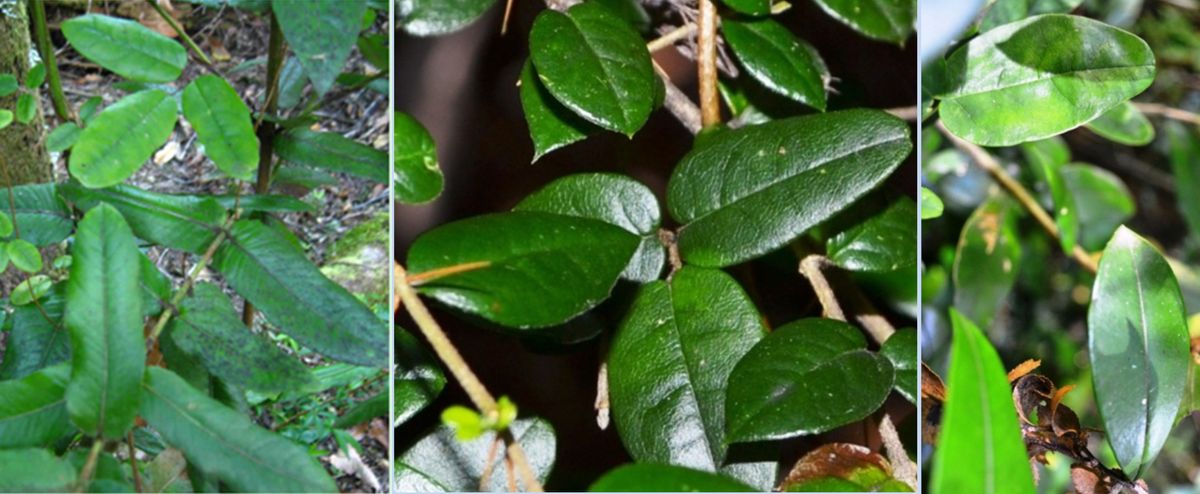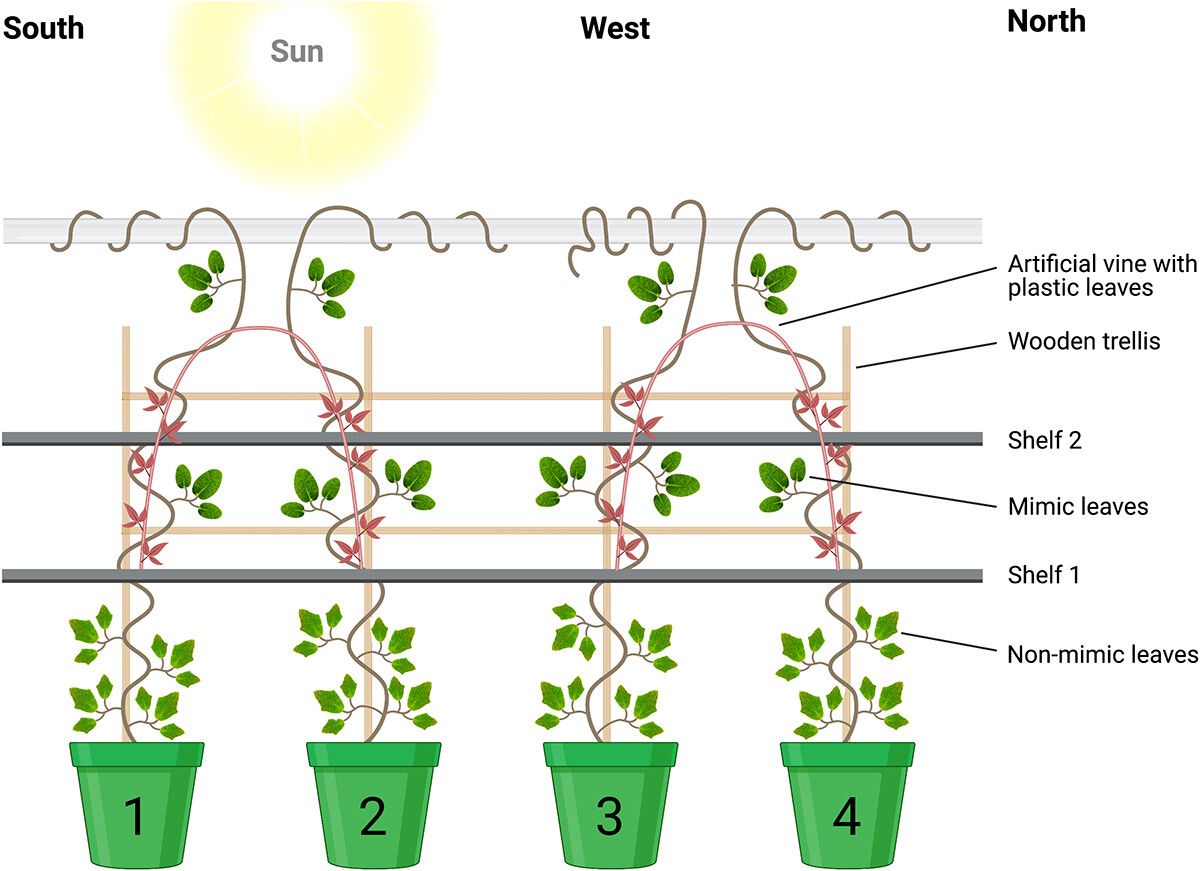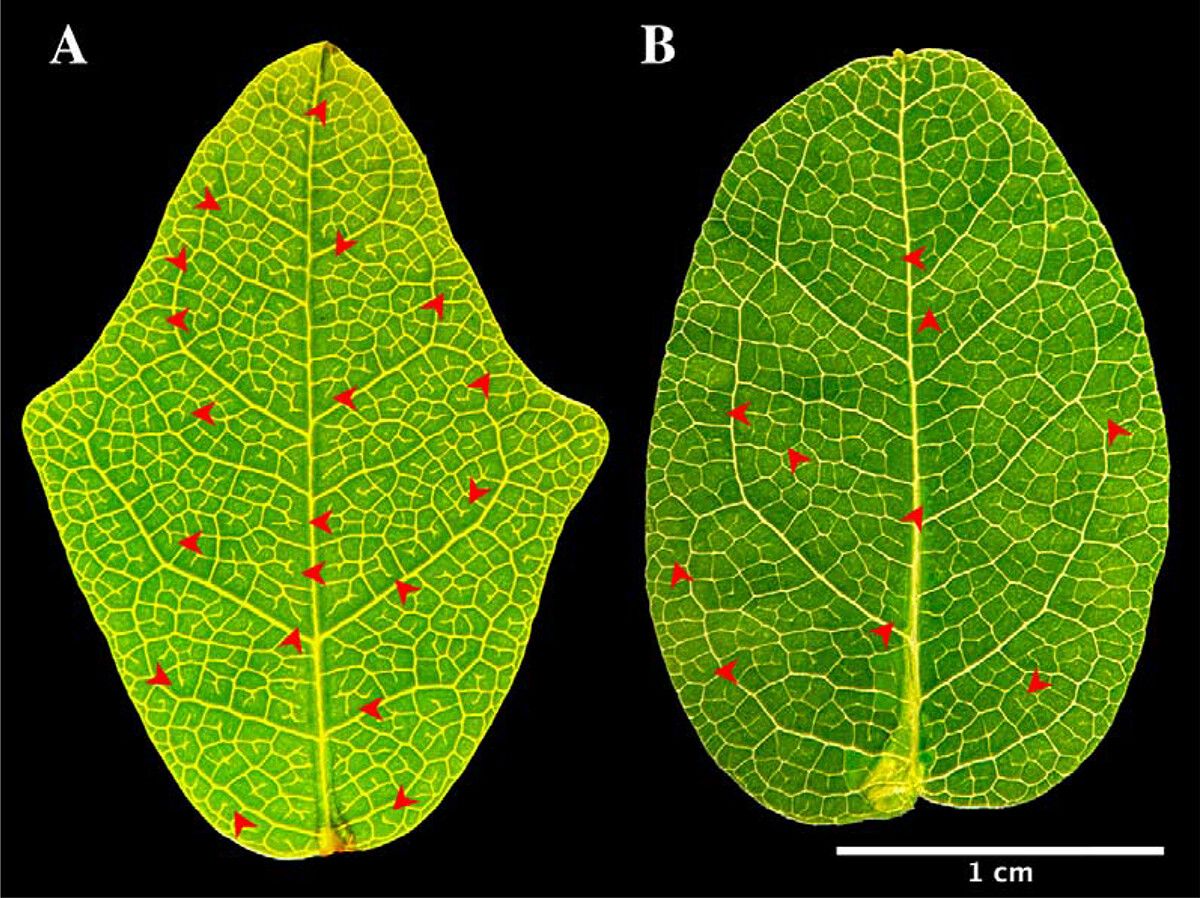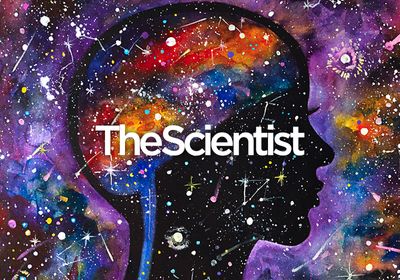ABOVE: The Boquila trifoliolata leaf on the left is how the leaves appear when the vine grows alone; the leaf on the right is purportedly mimicking a plastic leaf. Felipe Yamashita
The vine Boquila trifoliolata is a shapeshifter. As it winds its way up trees and other flora in the Chilean rainforest, its leaves change to resemble those of the plants it uses for support or, sometimes, neighbors it isn’t in contact with. It does such a good job of pretending to be other plants that although the vine was first described in the 1800s, its talent for impersonation remained secret until only about a decade ago. In the early 2010s, Ernesto Gianoli, a plant ecologist with the University of La Serena in Chile, realized that what appeared to be a strange-looking stem from a tree was in fact a B. trifoliata vine, the leaves of which perfectly blended in with the tree’s actual leaves. Once he saw that, he spotted the vine mimicking all sorts of plants—more than 20 species so far—by tweaking the size, shape, and color of its leaves.

Gianoli reported his findings in a 2014 Current Biology paper, but to this day, no one is certain how B. trifoliolata pulls off its impressive masquerades. Gianoli initially speculated that the vines pick up something from the plants they copy—volatile chemicals, perhaps, or genetic material that helps steer their leaves’ growth. Most recently, he discovered microbiome similarities between the mimicking vines and their models, hinting that bacteria could be involved. But in a paper published online last year in Plant Signaling and Behavior, citizen scientist Jacob White and University of Bonn graduate student Felipe Yamashita claim to have found evidence for a different hypothesis: that the vines can “see” other plants’ leaves, at least well enough to copy their looks.
See “Eyeless C. elegans Perceives Colors: Study”
To some, the paper was thrilling. It was recommended as “exceptional” on Faculty Opinions, a website where selected experts in the life sciences highlight notable, high-quality papers. And a viral TikTok video on the findings, posted by a popular plant-themed account, racked up more than 2.3 million views and 525,000 likes as of this story’s publication.
But some researchers sounded alarms. “This is a deeply flawed article based on a poorly designed experiment and reflects significant author bias in the interpretation of the results,” wrote Washington State University horticultural physiologist Linda Chalker-Scott in a blog post earlier this year.
Experts who spoke with The Scientist about the research similarly raised red flags about the study itself and had pointed questions about the publication process. Meanwhile, the study’s authors and handling editor stand by the paper, although they say it was never meant to be the final word on either plant vision or B. trifoliolata’s mimicry.
The one thing everyone agrees on is that these vines are remarkable—and that understanding how they perform their impersonations will change our understanding of how plants work.
A citizen scientist and a bold hypothesis
White, a homemaker in Utah with a passion for science and plants but with no formal scientific training, says he got the idea for the study after reading about the eye-spots of Chlamydomonas algae and the lens-like cells of certain cyanobacteria. He says he wondered if a similar sort of rudimentary vision might be common to all plants. That’s when he came across a 2016 mini-review by University of Bonn plant physiologist František Baluška and University of Florence plant neurobiologist Stefano Mancuso suggesting that plants have eye-like structures that afford them a form of vision. Eager to learn more, White ponied up the nearly $40 fee to view the article, he tells The Scientist.
In it, he read about botanist Gottlieb Haberlandt’s 1905 hypothesis that the upper epidermal cells of leaves may function as simple eyes (ocelli)—and about B. trifoliolata’s touchless mimicry, which the review authors suggested could be facilitated by the vines seeing their neighbors. White searched for follow-up experiments—and for anyone who seemed to be testing for vision in plants, and especially in the mimicking vines. But no one, it seemed, was actively looking into the idea.
“I think there’s a degree of dogmatism in science,” White says, which results in the premature rejection of ideas that challenge the current consensus.
He then thought about how such a test could be conducted. And that’s when it dawned on him: The other hypotheses about B. trifoliolata’s mimicry hinged on biological compounds transferring from model to vine. But if the vine can see, it might be fooled by anything that resembles a plant—including an artificial one, which would rule out a mechanism based on transfer of compounds. So White found a nursery in Port Townsend, Washington, with B. trifoliolata and ordered a vine for himself. After it arrived, he gave it a fake plant to grow on and waited.
Lo and behold, he says he observed what appeared to be an attempt by the vine to mimic the fake leaves as it grew up the artificial plant. Excited, he took pictures and sent them to Baluška. He didn’t really expect a response, he says, but when he got one, he was elated. Baluška suggested he try a fake plant that looks more like something that could be found in Chile. White did, and the vine seemed to mimic it as well.
At first, White says, he hoped Baluška would take these initial observations and use them to inform more rigorous experiments. “I’ve always felt that my lack of credentials is low hanging fruit for criticism” of his experiments, he says. So even when his wife bought him four more vines, “I sent [Baluška] an email and I was like: ‘I’ve got these plants. I don’t know how I’m going to get them to Germany, but I’ll send them to you,’” but Baluška encouraged White to do the experiment himself, he says.
White removed all other plants from a room in his house and set up the four vines by the window. He wanted to set one aside as a control plant, but there simply wasn’t space, and he couldn’t sacrifice any more of his home. So instead, the vines served as their own controls: They were placed beneath a set of shelves, the first of which separated their initial growth from artificial model plants. Once the vines grew past the shelf, they’d be growing alongside the fake leaves—and then White would compare the leaves in that part of the vine to the ones below the shelf. This kind of within-vine variation is seen in the wild, as Gianoli has observed vines changing their look as they grow past different plants.

In the first year, the leaves on the part of the vine that were exposed to the artificial plant were noticeably different from the leaves below the shelf, White says, but they weren’t great mimics. The next year, the vines sent out more shoots, and those leaves were even more like the artificial plants’ leaves, though still smaller. Over time, the leaves became more and more similar to the artificial ones.
White sent Baluška images and videos of the plants. Baluška recommended that White write up the work and submit it to the journal Plant Signaling and Behavior—of which Baluška is an editor-in-chief—and so he did.
Baluška then sent the paper out to nine reviewers, seven of whom provided feedback. The reviews were mixed, according to White, with some dismissing the study out of hand while others praised it for asking out-of-the-box questions.
One nearly universal critique was that the paper needed more hard data. So Baluška suggested that a graduate student in his lab, Felipe Yamashita, help White with morphological analyses. Yamashita says he wasn’t studying Boquila specifically before then, but was researching plant intelligence, so plant vision was right up his alley. Soon, White sent Yamashita leaves to measure and examine microscopically.

Yamashita’s morphological analyses indicated that the leaves above the shelf—the putative mimics—differed in shape from the leaves below, and in particular, the youngest leaves near the top of the vine diverged substantially from the oldest ones at its base. For instance, he noticed that the younger leaves’ small veins, called veinlets, tended to be connected to other veins, while the older leaves’ veins were more frequently open-ended. That was particularly intriguing, he says, because hormones are involved in generating leaf vein patterns; it’s therefore possible that the reduction in free veinlet ends as the vine grew indicates that there were different hormone levels in those leaves than in those that weren’t given anything to mimic.
Together, White and Yamashita revised the paper and resubmitted it, and Baluška accepted and published it.
Flaws in the foliage
Gianoli says he wasn’t approached to peer review the paper—which he now sees as a potential red flag, given that he’s one of the foremost experts on the vine. And in his view, the paper “should never have been published.”
He cites multiple flaws in the work, from numerous grammatical mistakes, to a lack of images that show the real and fake plants side-by-side, to what he says are serious issues with the experimental design. “Had they conducted their experiment properly, I would have said ‘Wow! Maybe I have to rethink my views,’” Gianoli says, but too many confounding variables were at play.
For example, he notes that the leaves below the shelf may have been more shaded, and therefore grew larger to capture as much light as possible. As the vine crossed into a more well-lit space, it could have started producing smaller leaves less prone to water loss; smaller leaves are going to be more rounded and less lobed—like those of the fake plant—simply because they’re smaller, he explains. Developmental age is also a confounding factor, he notes, as plants can display different leaves at different stages of their lives. “Those two factors [light and developmental stage] can explain the differences in phenotype,” he says.
I’ve always felt that my lack of credentials is low hanging fruit for criticism.
—Jacob White
The paper is “a textbook case of confirmatory bias,” says Gianoli. “The scientists fell in love with their hypothesis. . . . Once you are in love with your hypothesis, you force the systems to validate your view.”
University of Lausanne plant evolutionary biologist John Pannell, who wrote a somewhat critical commentary on Gianoli’s initial B. trifoliolata paper noting that it lacked what Pannell considered a plausible mechanism for the vine’s mimicry, expresses similar concerns with White’s experimental setup. He says the confounding factors make it “absolutely impossible” to draw any conclusions from the experiment.
Indeed, Pannell questions why the experiment was conducted before sufficient groundwork was in place to justify it. He says he expected the authors to make more of an effort to establish the feasibility of the idea, “explaining to the reader the optics of how that would actually work.” The paper, however, doesn’t delve into how plant vision might be plausible. “I think the paper does a very poor job in setting that up. . . . I don’t think they do their job at all, in fact. And that weakens the paper and the case for even doing this experiment.”
Moreover, he argues that the statistical analyses used—Student’s t-test and one-way analysis of variance—are inappropriate. “What we have here are measurements on the same plant for two different types of leaves. . . . They’re not independent,” he explains. “One of the key assumptions of those two tests is that all the measurements are independent. . . . So even if there wasn’t this problem of confounding, the statistical analysis is completely erroneous, and it means that the p values . . . do not mean anything, because the wrong test has been done.”
Pannell also says that the fact White and Yamashita labeled leaves “mimic” and “non-mimic” in the analyses “is jumping the gun in a very big way. And I think it shows the extent to which the authors are just really uncritical about this experiment.”
He adds that the authors are not the only ones to blame for the quality of the paper. “Whatever the review process is, it’s unbelievable that these experimental design flaws were not picked up.”
An undisclosed connection
Baluška—who describes himself as a plant physiologist turned cell biologist—has long contended that plants have some kind of vision. In addition to coauthoring the 2016 mini-review, he’s conducted extensive research on roots’ ability to sense light and grow toward darkness (skototropism). He has even reported what he considers to be an information processing region in roots, which could allow them to interpret information gleaned from light and function as brain-like structures. In all, he says that what he’s found has convinced him that roots have vision, and that this supports the possibility that leaves do, too.
See “Plant Cell Walls Can Control Growth in the Dark”
Baluška says he finds the pushback on the idea that plants can see “very strange” given findings of lens structures in cyanobacteria and camera-like eyespots in algae. “No one is really attacking these papers, but with plants, everyone is getting really [worked up],” he tells The Scientist.
Besides, other explanations for B. trifoliolata’s mimicry are lacking, he points out. “In order to mimic the spatial arrangement of some structures, chemicals are not useful. In order to have an idea about the shape or size, you need some kind of vision,” he argues.
Given that Baluška’s student was a coauthor, Baluška’s role in the publication process should have been disclosed, Pannell says. The authors and editor “need to declare that as a conflict of interest, and then the reader can decide whether that conflict of interest in any way compromises the interpretation of the results.”
It definitely raises questions about what’s getting into that journal.
—Adam Marcus, Retraction Watch
Adam Marcus, the editorial director at Medscape and cofounder of Retraction Watch, a blog and database that covers retractions and misconduct in scientific publishing, similarly questions the lack of disclosure, saying that situations like this are what conflict of interest statements are for. That the handling editor was the thesis advisor of one of the authors “definitely seems like the sort of thing that should have been disclosed on the paper itself,” he says. “I would go further to say that I think that the editor probably, just to avoid the appearance of a conflict of interest, should have passed that off to one of the three other editors-in-chief of the publication.”
“I have asked nine reviewers for their opinions in order to remove all the possible problems,” Baluška says in response to the potential conflict of interest.
But Marcus notes the lack of disclosure could reflect poorly on the journal as a whole. “This sort of thing makes you wonder how often this is happening in this journal,” he says. “And for the publisher, I mean . . . if I were [Taylor & Francis, the journal’s publisher], I think I’d want to look into it. . . . It definitely raises questions about what’s getting into that journal.”
The mystery of the mechanism
White and Yamashita stand by what they did and their working hypothesis. “I believe strongly that in the end, vision is the most likely answer, but there’s no way of knowing one hundred percent if you can’t disprove the others,” says White. “So I think there’s a lot more work that needs to be done.”
Gianoli, in turn, remains unconvinced that the vines can see. “I will never say it’s impossible that plants are able to see,” he says. “But so far, there’s no compelling evidence or even suggestive evidence that that is the case.”
Still, “I am thrilled by the idea that people are growing their own Boquilas at home,” he says. “We scientists, we need this [kind of] bold approach. We need these people that can think out of the box, and so on. But we cannot forget that there are rules in terms of what is evidence and what is not.”

Yamashita says he and his colleagues are already planning future studies. In addition to replicating White’s experiment with more plants and better controls, he says the lab is partnering with Mancuso’s group to probe the plant’s electrophysiology—to see whether there’s any sudden electrical activity in the vine when another plant is brought close by, for instance.
In fact, the team might already have new findings to report if it weren’t for one thing: Though the researchers have been growing the plants at the botanical garden run by the University of Bonn, they’ve struggled to propagate them. “There’s a lot of experiments that we can do. But the plant does not cooperate,” Yamashita laments.
Yamashita and Baluška explain that the vines simply don’t grow well on their own. But, of course, when they’re given other plants to climb, they start to mimic them.
Gianoli, too, has some B. trifoliolata specimens in his lab and has similarly struggled to grow them. They don’t seem to do well after transport, he says, and he suspects the few small ones that remain alive won’t survive long. That’s one of the reasons why he hasn’t conducted lab studies of his own on the plants.
He remains hopeful that field studies can elucidate the plant’s mimetic tricks, however. “I am passionate about this. I want to see it discovered before I die.”
Whatever the answer is, if researchers can uncover the mechanism of Boquila’s mimicry, they will likely discover something fundamental to plant biology that’s currently unknown, sources who spoke with The Scientist agree.
“I believe that we are going through a huge revolution in plant science,” says White. “New articles are coming out every day showing how amazing plants really are, and I’m proud that I could be a part of it.”
“Darwin once said that he was pleased to exalt plants to the state of organized beings,” he adds. “I can only imagine how he would feel about it now.”
Clarification (January 13, 2023): This article has been updated to better reflect Linda Chalker-Scott’s affiliation and field of research.






